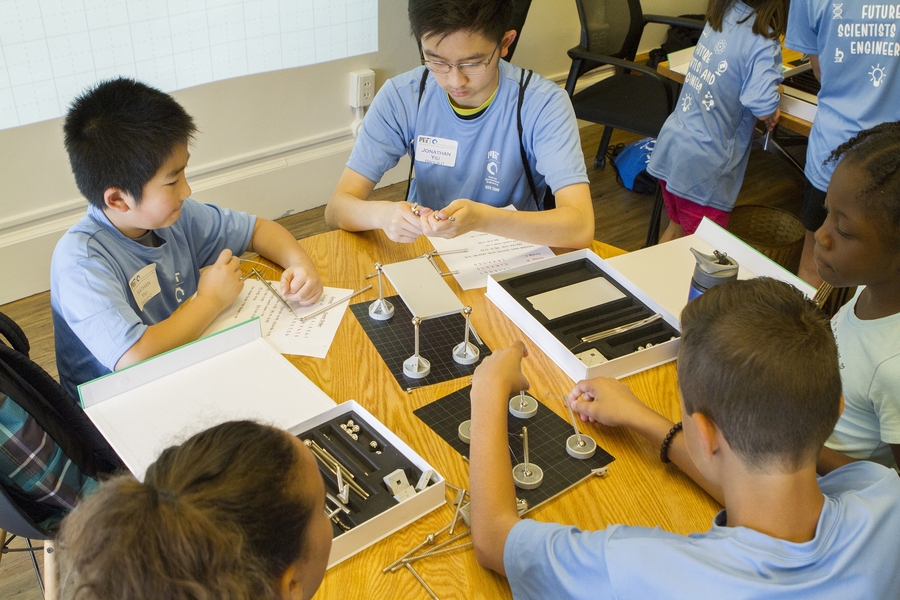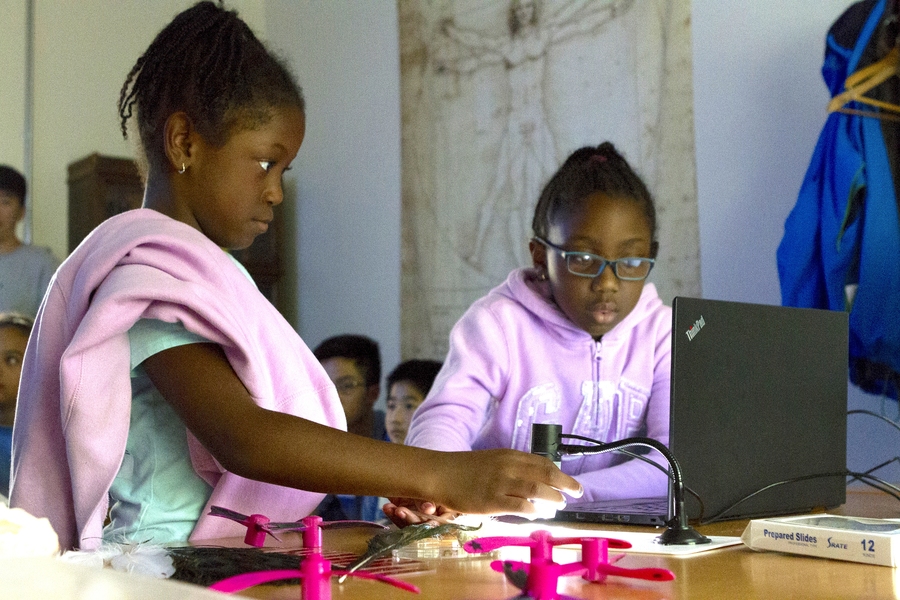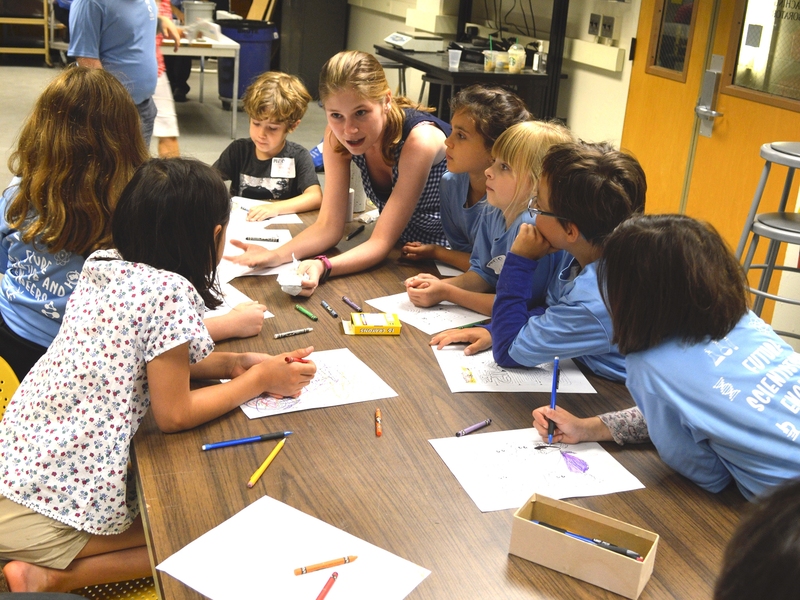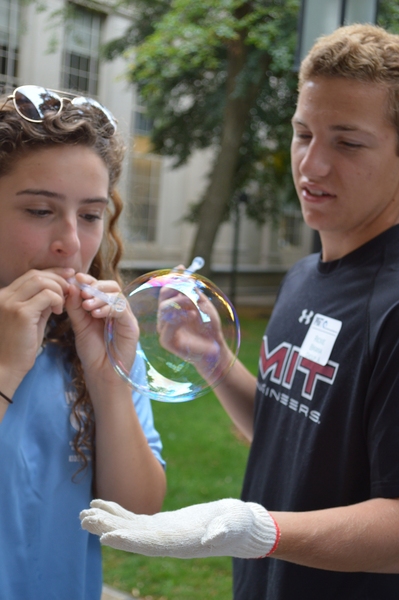The halls of MIT were abuzz with 30 children and teenagers eager to be civil and environmental engineers for a day.
All relatives, friends or neighbors of members of the Department of Civil and Environmental Engineering (CEE), the young additions to the community were on campus for the second annual CEE Kids Camp, a day filled with science, technology, engineering, and mathematics (STEM) activities that showcased research topics throughout the department.
“We started CEE Kids Camp last year to show friends and relatives of our community what it means to work in CEE and to inspire the next generation of STEM students,” said Markus Buehler, head of CEE and the McAfee Professor of Engineering. “All of the children were excited to attend the event and to share what they created throughout the day. The camp was a unique opportunity to sample the diverse research areas in CEE for young children to show them what it means to be a civil and environmental engineer.”
The one-day camp was held on Aug. 15, beginning with an orientation breakfast, where the group received schedules, camp shirts, bags, and CEE water bottles. The kids also learned about the environmental impact of disposable water bottles and the importance of using reusable ones — information that became trivia question material later in the day.
Led by volunteers from across the department, the camp consisted of seven stations featuring kid-friendly activities that exposed participants to a number of research areas, including fluid mechanics, concrete sustainability, earthquake-resistant structures, and bioinspired materials.
“All of the activities and presentations were created with kids of all ages in mind; you could tell that a lot of thought went into making sure that everything was at a level everyone could understand,” said Kathy Briana, the lead organizer of the camp and a CEE staff member. “It was a busy day hosting so many kids and teenagers, but it was a lot of fun.”
The participants were broken into smaller groups and took turns rotating between stations, which were hosted by faculty members, lecturers, students, and department affiliates. The tasks had varying levels of difficulty, but volunteers were on hand to guide each child through the activities.
Assistant Professor Tal Cohen, who specializes in nonlinear solid mechanics and material instabilities, hosted a session that invited children to build their own structures using a magnetic modeling kit. Participants were challenged to figure out how to build a structurally-sound model, and then to build bridges connecting their structure to their neighbor’s creation.
“I was expecting them to be much more creative than adults are, and it was very obvious that they were thinking of all kinds of solutions that we probably wouldn’t have even attempted,” Cohen said. “Some of them managed to have buildings with moving objects, some of them built forts, and some managed to build the bridge.”
Admir Masic, the Esther and Harold E. Edgerton Career Development Professor, and graduate student Hyun Chae “Chad” Loh led a demonstration about bioinspired materials, explaining how learning about biological materials and their designs can be hugely beneficial for the creation of new, high-performance, and more sustainable building materials. During his hands-on presentation, Masic allowed the kids to touch corals, shells, giant squid sucker rings, and silk cocoons, and to use an optical microscope to explore the intricate details of various natural samples, including a deep sea sponge. There was stiff competition to use the microscope, but each member of the group later got to wear 3-D glasses to get another look at the materials’ structures on the nanoscale. They also asked Masic questions about his work.
Outside, Marie-Julie Dalbe, a postdoc in Professor Ruben Juanes’ group, and undergraduate exchange student Hannah Galbraith-Olive used bubbles to explain the basics of fluid mechanics. Dalbe and her peers study multiphase flow, which is essentially studying the interactions between bubbles of two different fluids like water and oil, so simplifying their research into soap bubbles was a natural activity for kids, she explained.
Using a homemade bubble solution of soap and glycerin, Dalbe and Galbraith-Olive helped the campers explore what bubbles are, why they pop, and how bubbles can bounce. The participants experimented with blowing bubbles using cut plastic pipettes, mixed and tested their own solutions, and used bubble makers made of wood and rope to run through DuPont Court and create giant bubbles in their wake.
“The idea was to show them how to strengthen bubbles, like how to make them bigger and last longer. My vision was to help the kids figure out why bubbles pop, but they always said: ‘Because we pop them,’ ” Dalbe said with a laugh. “The goal was to explain how bubbles pop naturally, and how we could change that with different solutions and conditions.”
During other sessions, the camp attendees had the opportunity to create their own souvenirs. Graduate student Linda Seymour, postdoc Diego López Barreiro, and computer-aided design operator Steve Rudolph helped the participants mix their own rapid-setting cement and design coasters in petri dishes to take home. While waiting for the cement to set, the participants engaged in one of three sub-activities: a laboratory scavenger hunt, activity questionnaires, or coloring sheets, selected based on the age of the group.
Seymour discussed the history of cement and her research into sustainable concrete mixtures. She also told the group about her recent research trip to Italy, and let the participants look at a piece of ancient Roman concrete.
“It was a really great experience to share what we do and to get kids excited about engineering,” Seymour said. “I think it also really helped me as a researcher to think about how I’m presenting what I’m doing and being able to tailor my research to a diverse audience.”
The groups were also able to use the department’s advanced manufacturing equipment to create their own puzzles. The session, led by members the Laboratory for Atomistic and Molecular Mechanics (LAMM) including research scientists Zhao Qin and Francisco Martin-Martinez, graduate student Isabelle Su, and visiting scholar Flavia Libonati, invited the children to select images that would become the basis of a puzzle. The researchers then brought the students into the lab to see the laser cutter in action as it translated the images onto plastic and cut the material into puzzles for the participants to take home.
As engineers for the day, the groups were also tasked with building, testing and improving a variety of tools and designs. Doug Shattuck, a LAMM research affiliate and teacher at nearby Concord Middle School, and Najia Lloyd, a student member of the MIT-Concord Middle School Research Team, set up four stations for the camp participants to show their creativity and to try to build functional and well-designed devices. Among the tasks were building a marshmallow catapult with tongue depressors; using a magnet, battery, and wire to make a spinning motor; using a spool and pencil to create a racing dragster; and making a flying paper vortex. Shattuck established his personal benchmarks before the camp began, but his records were quickly beaten, and the kids were challenged with beating the records again and again throughout the day.
Shattuck found that the marshmallow catapult was the most popular activity. “I think the kids who were interested could get their minds into it more; it was a little bit easier to understand, and they could make it as simple or complicated as they wanted,” he said. “On the other hand, everybody could do it. And if they really wanted to, they could eat the marshmallows — as long as they didn’t hit the floor.”
The camp participants also learned how structures respond to earthquakes, and the importance of creating and understanding properly-engineered structures. CEE lecturer Gordana Herning explained to the group how earthquakes occur, showed the students how earthquakes are recorded in online databases, and showed the extent of the damage that they cause around the world.
Next, Herning challenged the children to build their own structures using string, pipe cleaners, and K’Nex building sets, and to consider what needed to be included in the designs to make the structures more resilient. The final task was to test the structures against an earthquake simulation using a shake table. Some structures were able to withstand the movement, but others ended up warped by the simulated disaster. At the end of the session, Herning identified potential areas for improvement in each creation and showed how critical the right designs can be for durability.
CEE Kids Camp wrapped up with an ice cream sundae bar and plastic water bottle trivia, where attendees competed to answer questions about the use of disposable water bottles, showed off their creations, and indulged in sweet treats.
“The kids were really impressive in all of the stations, and it was great to see them engaging with our researchers here at MIT throughout the day,” Buehler said. “Each year CEE Kids Camp improves, and it wouldn’t be possible without the help of our community members who volunteered time and energy towards making the event such a great success. We’re already looking forward to hosting the camp again next summer.”









